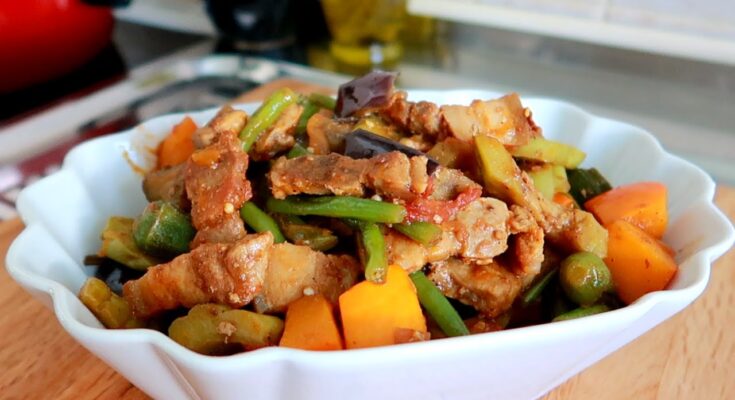Pinakbet Recipe: Pinakbet, also known as “pakbet,” is a traditional Filipino vegetable dish that’s both hearty and healthy. Originating from the northern regions of the Philippines, particularly the Ilocos region, Pinakbet is a colorful medley of vegetables like eggplant, bitter melon (ampalaya), okra, squash, and string beans. These veggies are flavored with fermented fish sauce called bagoong, making the dish savory, rich, and umami-packed.
Pinakbet is a common staple in Filipino households due to its simplicity, affordability, and the abundance of local vegetables. It’s often prepared with love and enjoyed by families around a shared dining table. What makes it unique is how each region, or even household, can add their own twist to it—whether it’s the type of vegetables used, the seasoning, or the protein included.
This dish isn’t just delicious—it’s a great way to eat your veggies while still indulging in bold Filipino flavors. Whether you’re cooking for a regular meal or a family gathering, Pinakbet always brings comfort and nostalgia to the table.
The Origins and Cultural Significance
Pinakbet’s roots go back to the Ilocano word “pinakebbet,” which means “shrunk” or “shrivelled,” a nod to the way the vegetables are cooked until tender and slightly wilted. The Ilocanos, known for their frugal lifestyle and love for healthy, plant-based dishes, crafted this recipe out of necessity and creativity, using whatever was in season from their backyards or markets.
Over time, Pinakbet has spread across the Philippines, evolving with each regional interpretation. While the original Ilocano version uses fermented fish sauce (bagoong isda), the Tagalog adaptation often substitutes it with bagoong alamang (fermented shrimp paste), which has a different flavor profile.
This dish is more than just food—it’s a story of heritage, sustainability, and culinary adaptability. Cooking Pinakbet is like embracing a piece of Filipino culture, where every bite tells a story of the land, the farmers, and the tradition that shaped it.
Ingredients for Pinakbet
Fresh Vegetables You’ll Need
Pinakbet is all about fresh, locally sourced vegetables. Here’s a list of the must-haves:
- Eggplant (Talong): Adds a soft, meaty texture when cooked.
- Bitter melon (Ampalaya): Gives the dish its signature bitter edge—slice thinly to tone it down.
- Okra: Slightly mucilaginous but great for texture.
- Squash (Kalabasa): Adds a sweet contrast and bright color.
- String beans (Sitaw): Long and crunchy, they bring in freshness and fiber.
- Tomatoes (Kamatis): Used both for base flavor and slight acidity.
- Onions and garlic: Foundational aromatics that enhance the taste.
- Ginger (optional): Adds warmth and depth.
All these veggies work together to create a balanced, nutrient-rich dish. You can find them easily at wet markets, local groceries, or even your backyard if you grow a garden.
Proteins and Flavor Enhancers
While the heart of Pinakbet is its vegetables, you can also add proteins for extra flavor and substance:
- Bagoong (Fermented Fish Sauce): The soul of Pinakbet. Salty and umami-rich.
- Pork belly or crispy pork bits: Adds fat and flavor—perfect for meat lovers.
- Shrimp or dried fish: Enhances umami without overpowering the vegetables.
The trick is to balance flavors. A little bagoong goes a long way. You want the veggies to shine, not drown in saltiness.
Optional Ingredients for Personal Twist
Want to make it your own? Here are some great add-ons:
- Green chili (siling haba): Adds subtle heat.
- Sweet corn: For a pop of sweetness.
- Bell peppers: For color and crunch.
- Tofu: A great vegetarian protein alternative.
Don’t be afraid to experiment! The beauty of Pinakbet is in its flexibility—what you have on hand is often good enough to make a wonderful dish.
Prepping the Ingredients
Washing and Cutting the Vegetables
Start with clean, prepped veggies—it makes everything easier later on.
- Wash thoroughly. Use clean water to remove dirt or pesticides.
- Chop uniformly. This ensures even cooking.
- Eggplants: Slice into half-moons.
- Ampalaya: Slice thin and soak in salt water to reduce bitterness.
- Okra: Keep whole or slice diagonally.
- Kalabasa: Peel and cube evenly.
- Sitaw: Cut into 2-inch lengths.
- Tomatoes: Quartered.
- Onion and garlic: Sliced and minced.
Take your time here. Prepping is half the battle. Get everything laid out before you start cooking to keep things smooth and stress-free.
Tips to Keep the Veggies Crisp
Nobody wants soggy vegetables in their Pinakbet. Here’s how to keep them just right:
- Do not overcook. Simmer just until veggies are tender but still bright.
- Layer wisely. Add hard veggies like squash first, and soft ones like okra and eggplant last.
- Cook uncovered. This prevents over-steaming and keeps colors vivid.
- Avoid stirring too much. It breaks the veggies and turns the dish mushy.
Crisp veggies mean better texture, flavor, and presentation. Cook with care and respect the ingredients!
Cooking the Perfect Pinakbet
Traditional Cooking Method
Cooking Pinakbet the traditional way is a labor of love. In Ilocano households, the dish is often cooked without sautéing—a method known as “no-gisa.” Instead, the ingredients are layered and steamed gently in their own juices and the flavorful bagoong. This minimalist method lets the earthy taste of each vegetable shine through.
Here’s how you do it the traditional way:
- Layering: Start by placing tomatoes, onions, and garlic at the bottom of a pot. These will create the base of the flavor.
- Add the vegetables: Begin with the hardest vegetables first—like squash—then layer on eggplant, bitter melon, okra, and sitaw.
- Add bagoong: Spoon in about 2 tablespoons of fermented fish sauce. You can dissolve it in a little water if it’s too thick.
- Simmer gently: Add about half a cup of water—just enough to steam, not boil. Cover the pot and cook over low heat.
- No stirring: Instead of stirring, gently shake the pot or use a spatula to scoop from the bottom up near the end of cooking.
- Cook until tender: Simmer for 10–15 minutes or until the vegetables are tender but not mushy.
This approach preserves the nutrients, color, and textures. You’ll notice how beautifully the natural flavors come through without the heaviness of oil or too much salt. It’s old-school cooking at its best!
Modern Method Using a Pan or Wok
Don’t have a clay pot or prefer a faster route? The pan-fried method works just as well and is perfect for busy home cooks.
Here’s a modern step-by-step guide:
- Heat oil in a pan or wok. Add about 1–2 tablespoons of cooking oil.
- Sauté aromatics. Toss in garlic, onions, and tomatoes. Cook until fragrant and slightly mushy.
- Add pork (optional). If using meat, brown it now until the fat renders and the meat is slightly crispy.
- Mix in the bagoong. Stir in your fish sauce or shrimp paste and let it cook for a minute to mellow out its saltiness.
- Add squash and water. These take the longest to cook. Pour in just enough water to create a light broth—about 1/2 to 3/4 cup.
- Add remaining vegetables. Start with the harder ones, adding okra and eggplant last.
- Simmer uncovered. Let everything cook for 10–15 minutes or until tender. Stir gently to prevent breaking the veggies.
This version gives you a richer flavor thanks to the sautéed base, and it’s still super healthy and satisfying. The pork or shrimp adds that extra savory depth, while the veggies stay vibrant and delicious.
Serving and Storage
Best Way to Serve Pinakbet
Pinakbet is at its best when served hot, fresh from the pot. It’s a dish that pairs incredibly well with freshly steamed white rice. The savory, umami-rich sauce seeps into the rice, creating that perfect bite every time.
Here are some ways to serve it:
- With rice: The classic combo—simple, comforting, and soul-satisfying.
- With grilled meat or fish: Grilled bangus (milkfish), tilapia, or pork chop on the side elevates the meal.
- As a main or side dish: Pinakbet is versatile enough to be the star of the show or the humble sidekick.
Want to impress guests? Serve it in a clay pot or rustic wooden bowl. Add some chopped green chilies for spice lovers, and you’ve got a homey yet flavorful Filipino dish that hits all the right notes.
How to Store Leftovers
Pinakbet stores surprisingly well, making it perfect for meal prep. Here’s how to keep it tasty even after a day or two:
- Cool completely: Let it sit at room temperature before transferring to a container.
- Use airtight containers: Helps retain moisture and prevent odor from spreading in the fridge.
- Refrigerate up to 3 days: Beyond that, the vegetables may become too soft and lose flavor.
- Reheat gently: Use a saucepan over low heat to warm through. Avoid microwaving in plastic to prevent soggy results.
You can even freeze it, although the texture of some vegetables like okra and squash might change slightly. For best results, consume within a week and always check for spoilage before reheating.
Nutritional Benefits of Pinakbet
Packed with Vitamins and Minerals
Pinakbet isn’t just delicious—it’s also a nutritional powerhouse. Because it’s mostly made from a variety of fresh vegetables, this dish provides a wide range of essential vitamins and minerals that contribute to overall wellness.
Here’s a breakdown of the key nutrients in Pinakbet:
- Vitamin A: Found in squash and tomatoes, it’s excellent for eye health and immune support.
- Vitamin C: Tomatoes, ampalaya, and string beans help boost immunity and promote healthy skin.
- Iron and Calcium: These come from leafy greens and string beans, supporting bone strength and preventing fatigue.
- Fiber: All the vegetables in Pinakbet are fiber-rich, aiding digestion and keeping you full longer.
- Potassium: Eggplants and squash are good sources of potassium, which helps regulate blood pressure.
This makes Pinakbet a heart-friendly and gut-friendly dish that suits nearly all dietary lifestyles. Whether you’re trying to lose weight, maintain your health, or simply eat cleaner, this humble dish checks all the boxes.
Low-Calorie and High-Fiber
Trying to stick to a low-calorie diet? Pinakbet is your friend. Since it’s primarily vegetables, it’s naturally low in calories and fat—especially when made without pork or oil. A single serving of Pinakbet can have as little as 100–150 calories, depending on what you include.
High fiber is another major perk. Fiber does wonders for the digestive system, helps regulate blood sugar levels, and keeps you feeling satisfied. Unlike fried or overly processed dishes, Pinakbet fills you up without weighing you down.
If you’re looking to lose weight or follow a plant-based lifestyle, consider making a vegetarian version. Use tofu or mushrooms for texture and protein, and you’ll still get all the savory satisfaction.
Variations of Pinakbet Around the Philippines
Ilocano-Style Pinakbet
The original Ilocano version of Pinakbet is rustic and simple, focusing on vegetables and fermented fish paste. It usually does not involve sautéing. Instead, all ingredients are layered in a clay pot and gently cooked with minimal liquid. This version typically includes:
- Bagoong isda (fermented fish paste)
- No pork or meat
- Emphasis on bitterness and natural vegetable flavors
The Ilocano-style is earthy, intense, and deeply rooted in tradition. It highlights the essence of minimalism in Filipino cooking—no frills, just pure flavor.
Tagalog-Style Pinakbet
The Tagalog region puts its own spin on Pinakbet. Here, shrimp paste (bagoong alamang) is used instead of fish paste, giving it a slightly sweeter and richer flavor. Tagalog-style Pinakbet is usually sautéed and may include pork, shrimp, or even crispy lechon bits.
Key differences include:
- Bagoong alamang (shrimp paste)
- Often sautéed with garlic, onions, and tomatoes
- Includes pork or seafood for added richness
This version is more savory and flavorful, catering to palates that prefer bold, robust dishes. It’s also more common in urban households due to the wider availability of ingredients.
Common Mistakes to Avoid
Overcooking the Vegetables
One of the biggest mistakes people make when cooking Pinakbet is overcooking the vegetables. Once overcooked, they lose not only their crunch but also their vibrant color and nutritional value.
Tips to avoid overcooking:
- Add vegetables in stages based on how long they take to cook.
- Keep the heat medium-low to prevent rapid softening.
- Check doneness often and remove from heat promptly.
Remember: Pinakbet is meant to be tender but not mushy!
Using Too Much Bagoong
Bagoong is powerful—delicious in small amounts, but overwhelming if used excessively. Too much can make your dish overly salty and ruin the balance of flavors.
How to fix an overly salty Pinakbet:
- Add more vegetables to absorb the salt.
- Stir in a bit of sugar to balance the saltiness.
- Add a splash of water or a wedge of tomato to mellow it out.
It’s better to start with a little and adjust as you go. Taste-testing is key!
FAQs about Pinakbet Recipe
1. What is Pinakbet made of?
Pinakbet is a traditional Filipino vegetable dish made with a medley of local vegetables like eggplant, bitter melon (ampalaya), okra, squash, and string beans, sautéed and simmered in fish sauce or fermented shrimp paste (bagoong).
2. Can I make Pinakbet without bagoong?
Yes, you can substitute bagoong with soy sauce, fish sauce, or miso paste for a different umami flavor if you prefer a milder taste or need a vegetarian option.
3. Is Pinakbet a healthy dish?
Absolutely! Pinakbet is packed with fiber, vitamins, and minerals thanks to its vegetable content. It’s low in fat and calories, making it a nutritious option for a balanced diet.
4. What meat can I add to Pinakbet?
Common additions include pork belly, shrimp, or dried fish to enhance the savory flavor. However, it’s equally delicious as a vegetarian dish.
5. Can I prepare Pinakbet in advance?
Yes. Pinakbet keeps well in the fridge for 2–3 days. Just store it in an airtight container and reheat gently before serving to preserve the texture of the vegetables.
6. What is the best way to serve Pinakbet?
It’s typically served hot with steamed white rice. You can pair it with grilled or fried meats for a complete Filipino meal.
Conclusion
Pinakbet is more than just a vegetable dish—it’s a cultural icon, a healthy meal, and a reminder of how beautiful simplicity can be. Whether you’re going for the traditional Ilocano style or adding a modern twist with pork and shrimp, this dish never disappoints. It’s loaded with flavor, nutrients, and heartwarming memories. Plus, it’s incredibly easy to customize based on your taste, lifestyle, or what’s available in your kitchen.
By following the steps in this guide, you can create a Pinakbet that’s authentic, delicious, and totally satisfying. Whether you’re a newbie or a seasoned home cook, Pinakbet deserves a spot in your weekly meal plan. So next time you’re craving comfort food with a healthy edge, you know what to make!



